Distributing hot water into a heat store to maintain thermal stratification in a system driven by natural convection.
History, and a proposal.
David M. Delaney, December 13, 2006
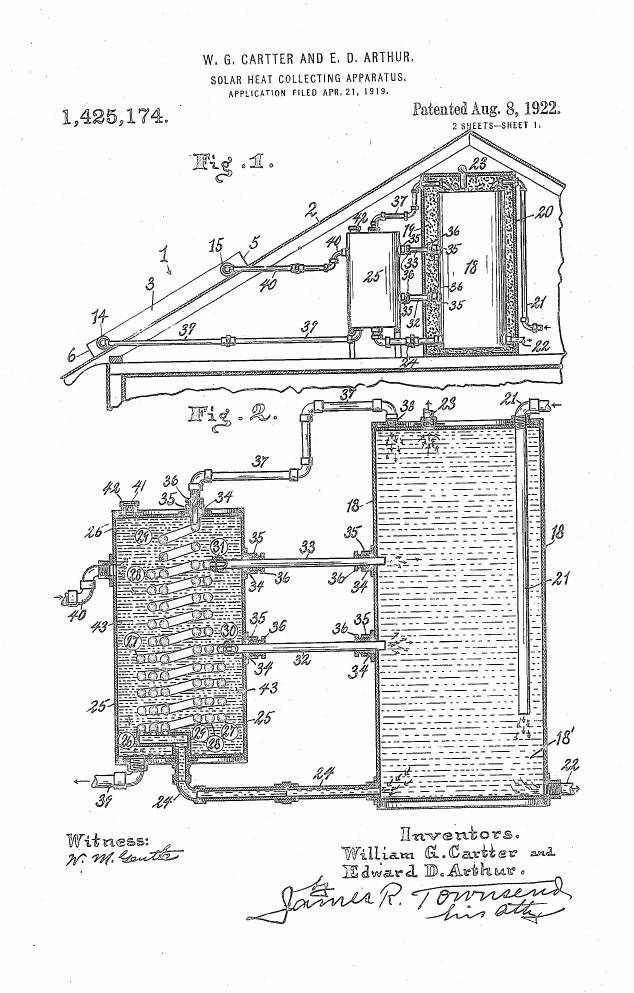
An
early solar water heater patented in 1922 by Cartter et al, US Patent
1,425,174. Water warmed by heat exchanger attached to the solar
collector enters the main storage tank at three levels according to
temperature, creating and maintaining thermal stratification.
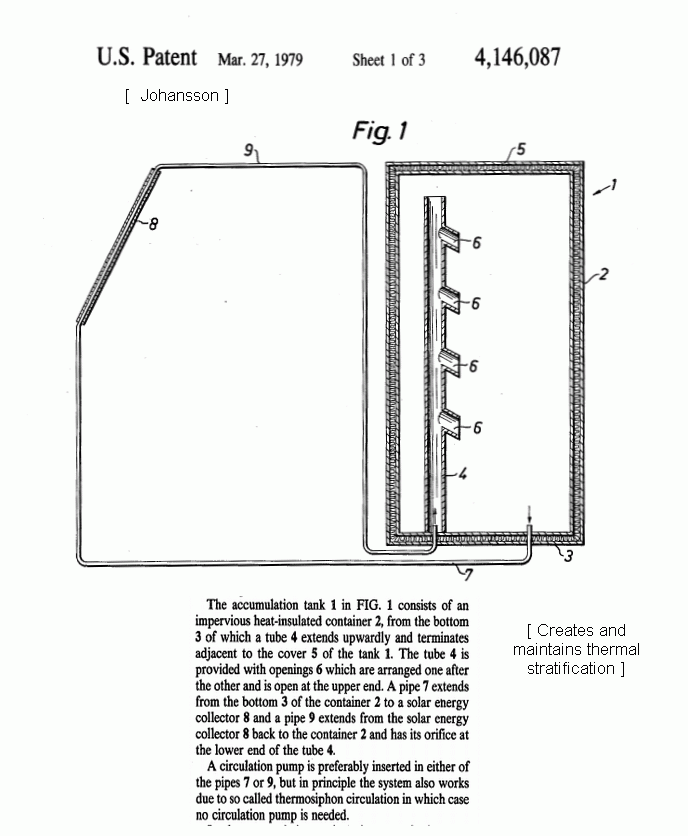
In 1979, Johansson patented a way of
distributing warm water entering a tank from a branching pipe rising
within the tank. US. Patent 4,146,087.
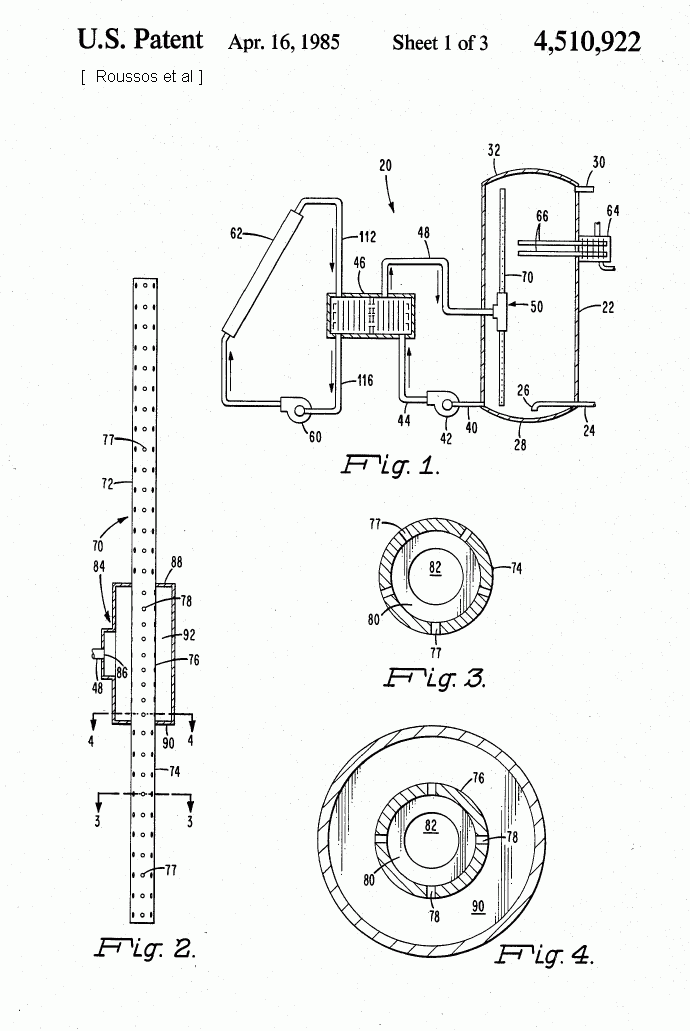
In 1985, Roussos et al patented a vertical perforated pipe, 77, and a momentum reducing device, 84, to
distribute warm water
within the tank. US. Patent 4,510,922. The momentum reducing device will not usually be required in thermosyphon systems.
From that article: "The returning water enters the tank via a
horizontal, wide-mouthed, "horn" or cone that slows it almost to a
stop, without turbulence, with the consequence that, by virtue of its
natural buoyancy, (whch depends solely on its temperature) it rises or
falls to join the temperature matching stratum."
Where circulation is powered entirely by natural convection, special
attention to slowing the already slow incoming water is not
required. It remains to minimize mixing as
the incoming water rises or falls to its temperature stratum. In
this circumstance a simplified narrow version of Shurcliff's horn
might provide considerable protection for the rising or falling incoming
water.
Proposal:
The version shown here is simpler than
any of the above schemes. It should be adequate for thermosyphon
systems. It is to be constructed from two CPVC pipes
and a Y connector. The pipes and the Y are slotted and assembled as
shown in Fig. 2 to provide a rising and a descending guide for the
incoming water. Both guides are sloped at 45 degrees. The slot of the
rising guide faces down. The slot of the descending guide faces up.
As with Shurcliff's horn, the slope of the pipes ensures that buoyancy
forces will keep the incoming water pressed against the pipe away from
the slot until it reaches its temperature stratum, reducing mixing.
The rising guide is shorter than the descending guide 1) because hot
water is more valuable than tepid water, which says it should be
exposed to less mixing hazard, and 2) becauses the dynamics of
cool water falling through warm water are different from the
dynamics of warm water rising through cool water. In the
case of cool water falling through warm water, the force
producing the movement is the force of gravity pulling the more dense
cool water down through the warmer water. The cool water forces its way
through the warmer water. In the case of warm water rising
through cool water, the force causing the upward movement is produced
by the heavier surrounding cool water squeezing into and under the warm
water at every level of its rise.
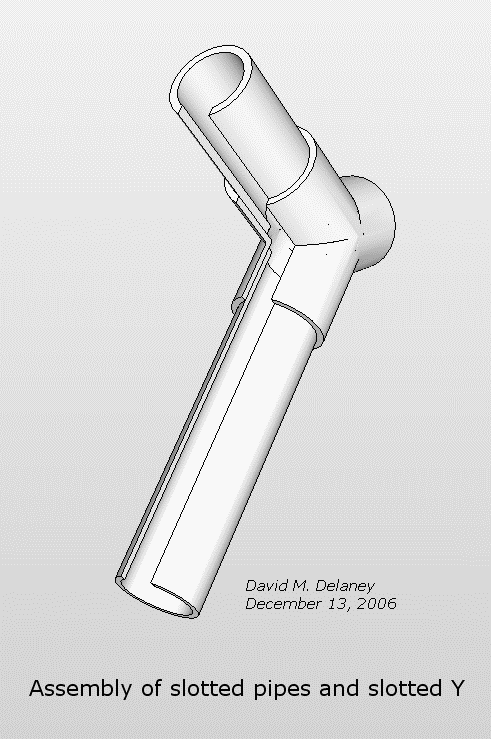
As
a result, the maintenance of a compact and steady rising stream of warm
water supplied from below in a tank of cool water is less likely than
the maintenance of a compact and steady descending stream of cool water
supplied from above in a tank of warm water. Rising warm water is
impelled by forces that tend to mix the ascending stream. Descending
cool water is impelled by a force that tends to keep the descending
stream compact and unmixed.
Home
 An
early solar water heater patented in 1922 by Cartter et al, US Patent
1,425,174. Water warmed by heat exchanger attached to the solar
collector enters the main storage tank at three levels according to
temperature, creating and maintaining thermal stratification.
An
early solar water heater patented in 1922 by Cartter et al, US Patent
1,425,174. Water warmed by heat exchanger attached to the solar
collector enters the main storage tank at three levels according to
temperature, creating and maintaining thermal stratification.
 In 1979, Johansson patented a way of
distributing warm water entering a tank from a branching pipe rising
within the tank. US. Patent 4,146,087.
In 1979, Johansson patented a way of
distributing warm water entering a tank from a branching pipe rising
within the tank. US. Patent 4,146,087. In 1985, Roussos et al patented a vertical perforated pipe, 77, and a momentum reducing device, 84, to
distribute warm water
within the tank. US. Patent 4,510,922. The momentum reducing device will not usually be required in thermosyphon systems.
In 1985, Roussos et al patented a vertical perforated pipe, 77, and a momentum reducing device, 84, to
distribute warm water
within the tank. US. Patent 4,510,922. The momentum reducing device will not usually be required in thermosyphon systems.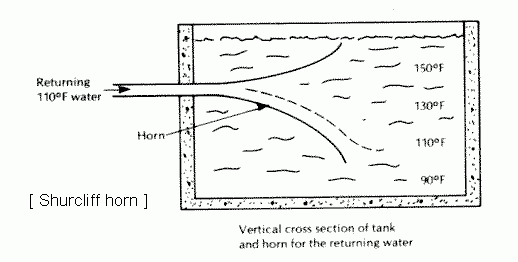
 As
a result, the maintenance of a compact and steady rising stream of warm
water supplied from below in a tank of cool water is less likely than
the maintenance of a compact and steady descending stream of cool water
supplied from above in a tank of warm water. Rising warm water is
impelled by forces that tend to mix the ascending stream. Descending
cool water is impelled by a force that tends to keep the descending
stream compact and unmixed.
As
a result, the maintenance of a compact and steady rising stream of warm
water supplied from below in a tank of cool water is less likely than
the maintenance of a compact and steady descending stream of cool water
supplied from above in a tank of warm water. Rising warm water is
impelled by forces that tend to mix the ascending stream. Descending
cool water is impelled by a force that tends to keep the descending
stream compact and unmixed.